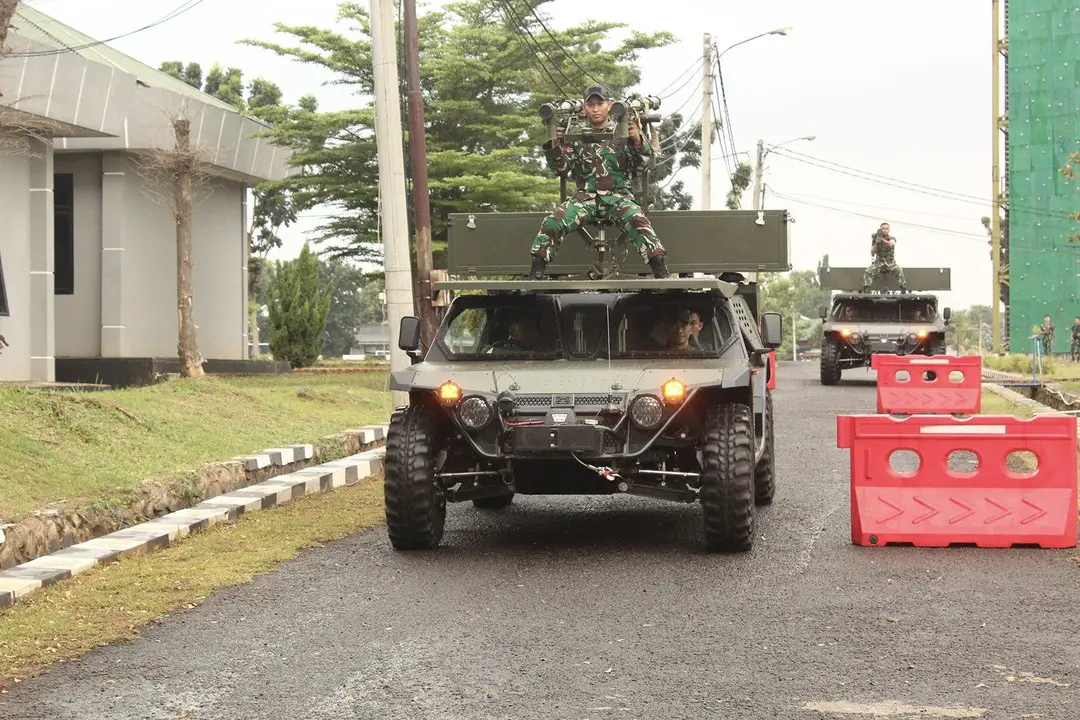Following its debut with the Thales FZ275 LGR laser-guided rocket variant at Eurosatory 2024 in Paris, SSE P6-ATAV (All Terrain Assault Vehicle) has once again captured the attention of netizens. This time, the spotlight is on the P6-ATAV variant equipped with a QW-3 twin launcher MANPADS (Man-Portable Air-Defense System) for Indonesian Air Force Kopasgat (Rapid Deployment Force Command). The integration of the QW-3 twin launcher atop the vehicle is reminiscent of the Pindad Komodo 4×4 Missile Launcher, which utilizes the Mistral missile with an Atlas twin launcher. However, the Komodo 4×4 features an armored chassis, while the P6-ATAV with the QW-3 twin launcher is an open-assault vehicle, offering distinct operational advantages and challenges. Unlike the fully armored P6-ATAV V3, this QW-3 equipped variant lacks ballistic protection on its sides and front, presenting a design closer to the first-generation P6-ATAV used by Indonesian Army Special Force Kopassus (Special Forces Command).

The P6-ATAV is a light strike vehicle designed by Indonesian defense company PT SSE (Surya Sentra Ekajaya) Defence. First introduced at the Indo Defence exhibition in 2016, it is categorized as a tactical vehicle by the Indonesian Armed Forces. The P6 features a tubular frame and an open-body design without doors or protective glass, constructed from high-grade steel and dual aluminum. The vehicle also features an open design without doors, enhancing its rapid deployment capabilities. Before deployment, the P6-ATAV underwent rigorous testing by Indonesian Air Force. Comprehensive physical inspections ensured all components, including the engine, electrical systems, and safety equipment like brakes, lights, and seat belts, were in optimal condition. Dynamic tests assessed the vehicle’s performance across various terrains, testing its responsiveness, stability during turns, and maneuverability in both open and rugged areas.

The vehicle supports three weapon mounting points, typically outfitted with a 7.62 mm machine gun. These mounts can also accommodate anti-tank missiles, anti-aircraft missiles, and miniguns. Despite its light armor, the P6 ensures agility and lightness. With a length of 4.6 meters, a width of 2.3 meters, and a height of 1.5 meters, the P6-ATAV is powered by a 2300 cc turbo diesel 4-cylinder engine, producing 142 HP at 3400 RPM. The rear-mounted engine, independent suspension, front winch, run-flat tires, and automatic transmission enhance its off-road capabilities. The vehicle has a fuel capacity of 120 liters, enabling a range of 500 km and a top speed of 120 km/h. The P6-ATAV V3 variant boasts full armor compliant with STANAG Level 1 standards, bulletproof glass, and run-flat tires. Two units can fit inside a C-130 Hercules aircraft. The V3 is also equipped with Reutech RCWS, which can mount either a 7.62 mm or 12.7 mm weapon, and the Metravib PILAR Gunshot Detection System.

The QW-series (Qian Wei) are man-portable air-defense systems (MANPADS) produced by China Aerospace Science and Industry Corporation (CASIC). QW-3 is the Chinese equivalent of French Mistral missile, with fuse developed from that of QW-2. The missile is unique among Chinese MANPAD in that this is the only surface-to-air missile that adopts the semi-active laser guidance similar to AGM-114 Hellfire. The gyro stabilized seeker provides very high degree of accuracy and is extremely effective against low altitude cruise missiles. The 15 degrees per second tracking rate of the seeker is relatively low in comparison for other MANPAD for supersonic targets in high g maneuver at very high altitudes, but this is by no means handicapping the performance because such targets are not intended to be for QW-3, which is specifically designed to engage terrain hugging helicopters and UAV’s and other fast flying targets at extremely low altitudes, including supersonic sea skimming cruise missiles.















